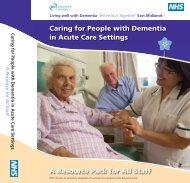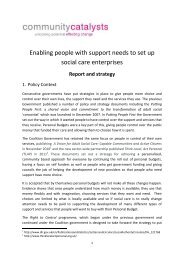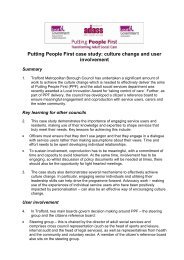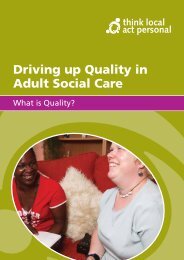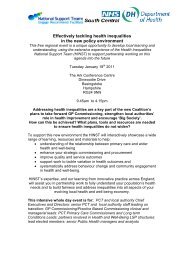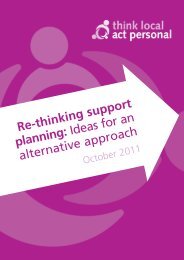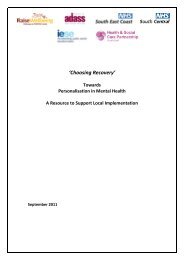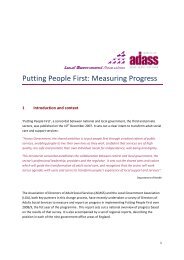Practical approaches to safeguarding and personalisation (pdf ...
Practical approaches to safeguarding and personalisation (pdf ...
Practical approaches to safeguarding and personalisation (pdf ...
You also want an ePaper? Increase the reach of your titles
YUMPU automatically turns print PDFs into web optimized ePapers that Google loves.
<strong>Practical</strong> <strong>approaches</strong> <strong>to</strong> <strong>safeguarding</strong> <strong>and</strong> <strong>personalisation</strong><br />
The same personalised approach that was used <strong>to</strong> set up the personal budget needs <strong>to</strong> be used<br />
<strong>to</strong> address the problem. This involves establishing with the person what has gone wrong <strong>and</strong><br />
working in partnership with them <strong>to</strong> resolve it. Sometimes the solution is better budgeting<br />
skills; sometimes it is referral for advice on debt management; sometimes it is family<br />
mediation; sometimes it is assisting the person <strong>to</strong> better manage his or her relationships. It<br />
may be about using a different money management system for the personal budget or<br />
providing greater support for managing the direct payment.<br />
If there is concern that a person has been abused or is at risk of abuse, local<br />
<strong>safeguarding</strong> adults procedures must always be followed.<br />
Case Study:<br />
The South West region is establishing clear principles <strong>to</strong> ensure a person remains in control of<br />
the process. It is intended that these will be published in their forthcoming guidance <strong>to</strong><br />
participation in <strong>safeguarding</strong> adults. They are:<br />
• Consent must be sought before initiating the <strong>safeguarding</strong> adults procedure unless<br />
there are other vulnerable people at risk, or the person concerned may die or be<br />
seriously injured if the procedure is not initiated. If the <strong>safeguarding</strong> adults procedure<br />
is <strong>to</strong> be used without the persons consent, they must be informed <strong>and</strong> continue <strong>to</strong> be as<br />
much part of the procedure as they wish. If a person. If a person is assessed as not<br />
having the capacity <strong>to</strong> consent, then the principles of the Mental Capacity Act must be<br />
followed.<br />
• The outcomes the person wants from the use of the <strong>safeguarding</strong> adults procedure<br />
should be ascertained, clearly recorded at the beginning <strong>and</strong> form the basis for any<br />
safety or protection planning.<br />
• People should have access <strong>to</strong> appropriate advocacy <strong>and</strong> support throughout the <br />
procedure <strong>and</strong> afterwards. <br />
• People should be able <strong>to</strong> participate in whatever way they prefer. Any protection or<br />
safety plan will be most effective if the person it relates <strong>to</strong> has been active in<br />
formulating it.<br />
Personalisation means working with the person <strong>and</strong> their carers <strong>to</strong> address the problem. Most<br />
things that go wrong can be used as learning experiences for all concerned. The aim is <strong>to</strong><br />
support the person <strong>to</strong> manage better.<br />
Safeguarding teams should be seen as part of the council system that works <strong>to</strong> put things<br />
right. Safeguarding teams are trained <strong>to</strong> assess concerns of ‘significant harm’. They have<br />
skills <strong>and</strong> experience in investigating concerns <strong>and</strong> calling <strong>safeguarding</strong> meetings, where there<br />
are discussions <strong>and</strong> plans for managing risk of significant harm.<br />
21



